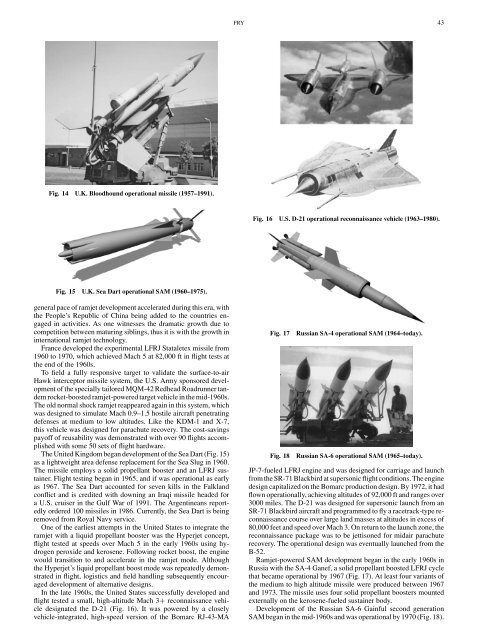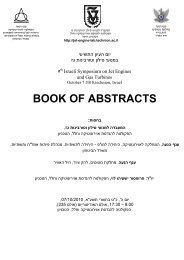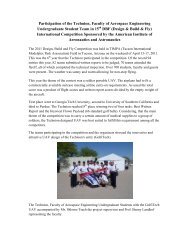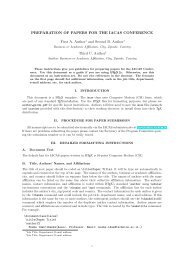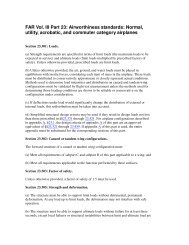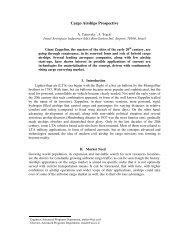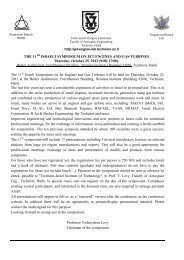A Century of Ramjet Propulsion Technology Evolution - Faculty of ...
A Century of Ramjet Propulsion Technology Evolution - Faculty of ...
A Century of Ramjet Propulsion Technology Evolution - Faculty of ...
Create successful ePaper yourself
Turn your PDF publications into a flip-book with our unique Google optimized e-Paper software.
Fig. 14 U.K. Bloodhound operational missile (1957–1991).<br />
Fig. 15 U.K. Sea Dart operational SAM (1960–1975).<br />
general pace <strong>of</strong> ramjet development accelerated during this era, with<br />
the People’s Republic <strong>of</strong> China being added to the countries engaged<br />
in activities. As one witnesses the dramatic growth due to<br />
competition between maturing siblings, thus it is with the growth in<br />
international ramjet technology.<br />
France developed the experimental LFRJ Stataletex missile from<br />
1960 to 1970, which achieved Mach 5 at 82,000 ft in flight tests at<br />
the end <strong>of</strong> the 1960s.<br />
To field a fully responsive target to validate the surface-to-air<br />
Hawk interceptor missile system, the U.S. Army sponsored development<br />
<strong>of</strong> the specially tailored MQM-42 Redhead Roadrunner tandem<br />
rocket-boosted ramjet-powered target vehicle in the mid-1960s.<br />
The old normal shock ramjet reappeared again in this system, which<br />
was designed to simulate Mach 0.9–1.5 hostile aircraft penetrating<br />
defenses at medium to low altitudes. Like the KDM-1 and X-7,<br />
this vehicle was designed for parachute recovery. The cost-savings<br />
pay<strong>of</strong>f <strong>of</strong> reusability was demonstrated with over 90 flights accomplished<br />
with some 50 sets <strong>of</strong> flight hardware.<br />
The United Kingdom began development <strong>of</strong> the Sea Dart (Fig. 15)<br />
as a lightweight area defense replacement for the Sea Slug in 1960.<br />
The missile employs a solid propellant booster and an LFRJ sustainer.<br />
Flight testing began in 1965, and if was operational as early<br />
as 1967. The Sea Dart accounted for seven kills in the Falkland<br />
conflict and is credited with downing an Iraqi missile headed for<br />
a U.S. cruiser in the Gulf War <strong>of</strong> 1991. The Argentineans reportedly<br />
ordered 100 missiles in 1986. Currently, the Sea Dart is being<br />
removed from Royal Navy service.<br />
One <strong>of</strong> the earliest attempts in the United States to integrate the<br />
ramjet with a liquid propellant booster was the Hyperjet concept,<br />
flight tested at speeds over Mach 5 in the early 1960s using hydrogen<br />
peroxide and kerosene. Following rocket boost, the engine<br />
would transition to and accelerate in the ramjet mode. Although<br />
the Hyperjet’s liquid propellant boost mode was repeatedly demonstrated<br />
in flight, logistics and field handling subsequently encouraged<br />
development <strong>of</strong> alternative designs.<br />
In the late 1960s, the United States successfully developed and<br />
flight tested a small, high-altitude Mach 3+ reconnaissance vehicle<br />
designated the D-21 (Fig. 16). It was powered by a closely<br />
vehicle-integrated, high-speed version <strong>of</strong> the Bomarc RJ-43-MA<br />
FRY 43<br />
Fig. 16 U.S. D-21 operational reconnaissance vehicle (1963–1980).<br />
Fig. 17 Russian SA-4 operational SAM (1964–today).<br />
Fig. 18 Russian SA-6 operational SAM (1965–today).<br />
JP-7-fueled LFRJ engine and was designed for carriage and launch<br />
from the SR-71 Blackbird at supersonic flight conditions. The engine<br />
design capitalized on the Bomarc production design. By 1972, it had<br />
flown operationally, achieving altitudes <strong>of</strong> 92,000 ft and ranges over<br />
3000 miles. The D-21 was designed for supersonic launch from an<br />
SR-71 Blackbird aircraft and programmed to fly a racetrack-type reconnaissance<br />
course over large land masses at altitudes in excess <strong>of</strong><br />
80,000 feet and speed over Mach 3. On return to the launch zone, the<br />
reconnaissance package was to be jettisoned for midair parachute<br />
recovery. The operational design was eventually launched from the<br />
B-52.<br />
<strong>Ramjet</strong>-powered SAM development began in the early 1960s in<br />
Russia with the SA-4 Ganef, a solid propellant boosted LFRJ cycle<br />
that became operational by 1967 (Fig. 17). At least four variants <strong>of</strong><br />
the medium to high altitude missile were produced between 1967<br />
and 1973. The missile uses four solid propellant boosters mounted<br />
externally on the kerosene-fueled sustainer body.<br />
Development <strong>of</strong> the Russian SA-6 Gainful second generation<br />
SAM began in the mid-1960s and was operational by 1970 (Fig. 18).


